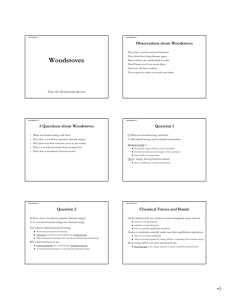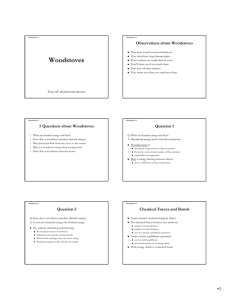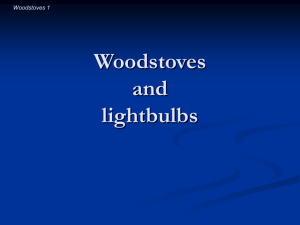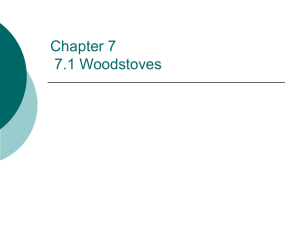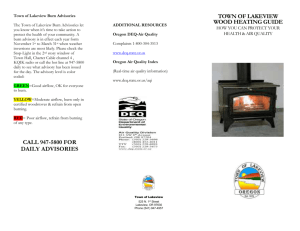Woodstoves Woodstoves 1
advertisement
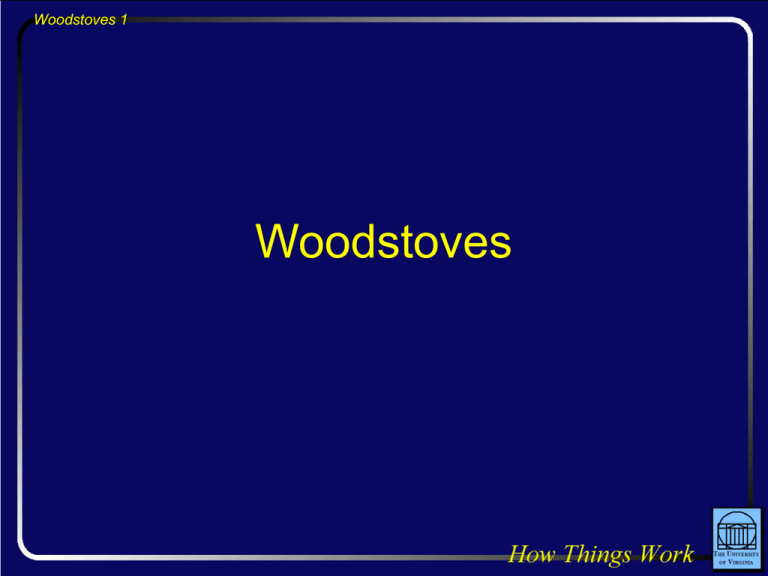
Woodstoves 1 Woodstoves Woodstoves 2 Question Which is more effective at heating a room: • a black woodstove • a shiny chrome-plated woodstove Woodstoves 3 Observations About Wood Stoves • • • • • • They burn wood inside closed fireboxes They often have long chimney pipes They are usually black You get burned if you touch them Heat rises off their surfaces It feels hot to stand near them Woodstoves 4 Thermal Energy • • • • is disordered energy is kinetic and potential energies of atoms gives rise to temperature does not include order energies: – kinetic energy of an object moving or rotating – potential energy of outside interactions Woodstoves 5 Heat • is energy that flows between objects because of their difference in temperature • is thermal energy on the move • Technically, objects don’t contain “heat” Woodstoves 6 Burning Wood • Fire releases chemical potential energy – Wood and air consist of molecules – Molecules are bound by chemical bonds – When bonds rearrange, they release energy – Burning involves bond rearrangement Woodstoves 7 Chemical Forces, Part 1 • Atoms interact via electromagnetic forces • Large separations: atoms attract – Attraction is weak at great distances – Attraction gets stronger as atoms get closer – Attraction reaches a maximum strength – Attraction weakens as they approach further Woodstoves 8 Chemical Forces, Part 2 • Medium separations: equilibrium – Attraction vanishes altogether at equilibrium • Small separations: atoms repel – Repulsion gets stronger as atoms get closer Woodstoves 9 Chemical Bonds, Part 1 • When atoms are brought together, they – do work – release chemical potential energy • By the time they reach equilibrium, they – have released a specific amount of energy – have become bound together chemically Woodstoves 10 Chemical Bonds, Part 2 • To separate the atoms, – you must do work on them – return the specific amount of energy to them Woodstoves 11 Chemical Concepts • • • • • Molecule: atoms joined by chemical bonds Chemical bond: chemical-force linkages Bond strength: work needed to break bond Reactants: starting molecules Reaction products: ending molecules Woodstoves 12 Chemical Reactions • Breaking old bonds takes work • Forming new bonds does work • If new bonds are stronger than old, – chemical potential energy thermal energy • Breaking old bonds requires energy – reaction requires activation energy to start Woodstoves 13 Burning Wood • Reactants: carbohydrates and oxygen • Products: water and carbon dioxide • Activation energy: a burning match Woodstoves 14 Thermal Energy and Bonds • Thermal energy causes atoms to vibrate • Atoms vibrate about stable equilibrium – Experience restoring forces about equilibrium – Energy goes: potentialkineticpotential… – Total energy is constant unless transferred • Temperature set by thermal kinetic energy Woodstoves 15 Heat and Temperature • Objects exchange thermal energy – Microscopic energy flows both ways – Average energy flows from hotter to colder • Temperature predicts energy flow direction – No flow thermal equilibrium same temp • Temperature is: – Average thermal kinetic energy per particle Woodstoves 16 Open Fire • Burns wood to release thermal energy • Good features: – Heat flows from hot fire to cold room • Bad features: – Smoke enters room – Fire uses up room’s oxygen – Can set fire to room Woodstoves 17 Fireplace • Burns wood to release thermal energy • Good features: – Heat flows from hot fire to cold room – Smoke goes mostly up chimney – New oxygen enters room through cracks – Less likely to set fire on room • Bad features: – Inefficient at transferring heat to room Woodstoves 18 Woodstove • Burns wood to release thermal energy • Good features: – Heat flows from hot fire to cold room – All the smoke goes up chimney pipe – New oxygen enters room through cracks – Relatively little fire hazard – Transfers heat efficiently to room Woodstoves 19 Heat Exchanger • Woodstove is a heat exchanger – Separates air used by the fire from room air – Transfers heat without transferring smoke Woodstoves 20 Heat Transfer Mechanisms • • • • Conduction: heat flow through materials Convection: heat flow via moving fluids Radiation: heat flow via light waves All three transfer heat from hot to cold Woodstoves 21 Conduction • Heat flows but atoms don’t • In an insulator, – adjacent atoms jiggle one another – atoms do work and exchange energies – on average, heat flows from hot to cold atoms • In a conductor, – mobile electrons carry heat long distances – heat flows quickly from hot to cold spots Woodstoves 22 Woodstoves • Conduction – moves heat through the stove’s metal walls Woodstoves 23 Convection • Fluid transports heat stored in its atoms – Fluid warms up near a hot object – Flowing fluid carries thermal energy with it – Fluid cools down near a cold object – Overall, heat flows from hot to cold • Natural buoyancy drives convection – Warmed fluid rises away from hot object – Cooled fluid descends away from cold object Woodstoves 24 Woodstoves • Conduction – moves heat through the stove’s metal walls • Convection – circulates hot air around the room Woodstoves 25 Radiation • Heat flows by electromagnetic waves (radio waves, microwaves, light, …) • Wave types depend on temperature – cold: radio wave, microwaves, infrared light – hot: infrared, visible, and ultraviolet light • Higher temperature more radiated heat • Black emits and absorbs light best Woodstoves 26 Stefan-Boltzmann Law • The amount of heat a surface radiates is power emissivity Stefan-Boltzmann constant temperature surface area 4 • where emissivity is emission efficiency • Emissivity – 0 is worst efficiency: white, shiny, or clear – 1 is best efficiency: black Woodstoves 27 Woodstoves • Conduction – moves heat through the stove’s metal walls • Convection – circulates hot air around the room • Radiation – transfers heat directly to your skin as light Woodstoves 28 Campfires • No conduction, unless you touch hot coals • No convection, unless you are above fire • Lots of radiation: – your face feels hot – your back feels cold Woodstoves 29 Question Which is more effective at heating a room: • a black woodstove • a shiny chrome-plated woodstove Woodstoves 30 Summary About Wood Stoves • • • • Use all three heat transfer mechanisms Have tall chimneys for heat exchange Are black to encourage radiation Are sealed to keep smoke out of room air
